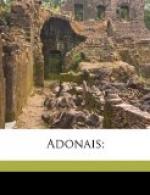+Stanza 46,+ 11. 3, 4. And where its wrecks like shattered mountains rise, And flowering weeds, &c. These expressions point more especially, but not exclusively, to the Coliseum and the Baths of Caracalla. In Shelley’s time (and something alike was the case in 1862, the year when the present writer saw them first) both these vast monuments were in a state wholly different from that which they now, under the hands of learned archaeologists and skilled restorers, present to the eye. Shelley began, probably in 1819, a romantic or ideal tale named The Coliseum; and, ensconced amid the ruins of the Baths of Caracalla, he composed, in the same year, a large part of Promethens Unbound. A few extracts from his letters may here be given appropriately. (To T.L. Peacock, 22 December, 18i8). ’The Coliseum is unlike any work of human hands I ever saw before. It is of enormous height and circuit, and the arches, built of massy stones, are piled, on one another, and jut into the blue air, shattered into the forms of overhanging rocks. It has been changed by time into the image of an amphitheatre of rocky hills overgrown by the wild olive, the myrtle, and the figtree, and threaded by little paths which wind among its ruined stairs and immeasurable galleries: the copsewood overshadows you as you wander through its labyrinths.’—(To the same, 23 March, 1819). ’The next most considerable relic of antiquity, considered as a ruin, is the Thermae of Caracalla. These consist of six enormous chambers, above 200 feet in height, and each enclosing a vast space like that of a field. There are in addition a number of towers and labyrinthine recesses, hidden and woven over by the wild growth of weeds and ivy. Never was any desolation so sublime and lovely.... At every step the aerial pinnacles of shattered stone group into new combinations of effect, and tower above the lofty yet level walls, as the distant mountains change their aspect to one travelling rapidly along the plain.... Around rise other crags and other peaks—all arrayed, and the deformity of their vast desolation softened down, by the undecaying investiture of Nature.’
1. 7. A slope of green access. The old Protestant Cemetery. Shelley described it thus in his letter to Mr. Peacock of 22 December, 1818. ’The English burying-place is a green slope near the walls, under the pyramidal tomb of Cestius, and is, I think, the most beautiful and solemn cemetery I ever beheld. To see the sun shining on its bright grass, fresh, when we visited it, with the autumnal dews, and hear the whispering of the wind among the leaves of the trees which have overgrown the tomb of Cestius, and the soil which is stirring in the sun-warm earth, and to mark the tombs, mostly of women and young people who were buried there, one might, if one were to die, desire the sleep they seem to sleep. Such is the human mind, and so it peoples with its wishes vacancy and oblivion.’—See also pp. 69, 70.




